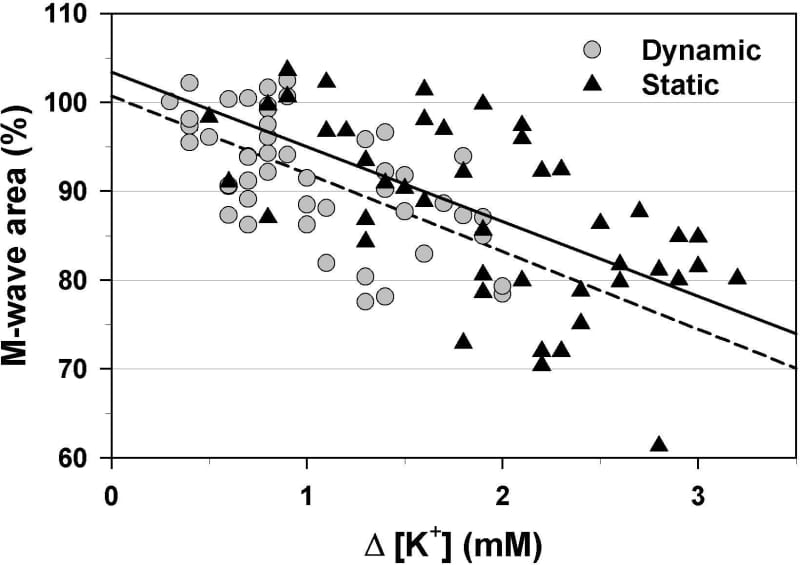The elevation of extracellular potassium concentration depolarizes the sarcolemma (1) and therefore can result in a loss of excitability. This effect is widely discussed as a possible cause of muscle fatigue. On the other hand, muscle activity stimulates the Na+-K+ pump too, which contributes to recovery of RMP and therefore excitability and contractility. In our study the effects of the elevated venous [K+] ([K+]v) has been proved during handgrip exercise. The study was performed according to the Declaration of Helsinki. Each of nine male volunteers performed 12 exercise bouts of 1 min separated by 4 min of rest after the 15 min warm-up phase and following 4 min resting. During warming-up the subjects lifted a 7.5 kg weight for 2.5 s. During the test phase dynamic (DE) and static (SE) exercise bouts were altered. The subjects had to lift the weight and to keep it at a constant level during SE and to lift the weight with maximal speed during DE using the forearm muscles only. The weight was varied randomly between 5 and 30 kg with steps of 5 kg. Blood was drawn from the cubital vein draining the working forearm. To conserve blood composition during measurements, the blood flow in the exercising arm was occluded after 55 s of exercise for 15-20 s. M-wave recording and blood sampling took place just before and immediately after each exercise period. Acid-base state, lactate, [K+]v and [Na+]v in plasma were determined. EMG was recorded via surface electrodes. The motor point of the muscle was stimulated supramaximally with rectangular current pulses. M-waves were analysed for area of the negative phase and duration. A t test was used to identify different means. All data are expressed as mean ± S.D. After warming-up and following 4 min resting the M-wave area increased by 24.9±19.6% (p<0.01, n=9). [K+]v decreased thereby from 4.1±0.3 to 3.5±0.2 mM (p<0.01, n=9). Thereafter pre-exercise values of both [K+]v and M-wave area remained at these levels. Muscle force during SE and power during DE decreased intensity-dependently. [K+]v correlated with changes of total EMG both in DE (r2=0.75, P<0.001, n=54) and SE (r2=0.62, P<0.001, n=54). Changes of [K+]v correlated negatively with M-wave area (r2=0.37, p<0.001, n=54) (Fig. 1). The median power frequency of EMG decreased during exercise intensity-dependent (r2=0.43 for SE, r2=0.21 for DE, p<0.001, n=54). Nevertheless, M-waves did not show any sign of decrease of the muscle AP propagation velocity and the M-wave area never decreased below the initial value. It can be concluded, that in spite of decrease of M-wave area with elevation of [K+]v there should be another cause, maybe of the central origin, for the decrease of muscle force.
University of Bristol (2005) J Physiol 567P, C49
Oral Communications: Extracellular potassium concentration, muscle electrical activity and efficiency during voluntary exercise with a small muscle group
Shushakov, Vladimir; Stubbe, Christian; Maassen, Norbert;
1. Sport Physiology, Medical School, Hannover, Hanover, Germany.
View other abstracts by:
Figure 1. Relations between venous potassium and M-wave area
Where applicable, experiments conform with Society ethical requirements.

